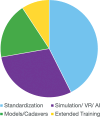Residency Education Practices in Endoscopic Skull Base Surgery
- PMID: 39444777
- PMCID: PMC11495901
- DOI: 10.1055/a-2226-8294
Residency Education Practices in Endoscopic Skull Base Surgery
Abstract
Background There has been increased interest in how residents train in the subspecialty of skull base surgery. Examining which training methods are popular and effective to optimize residency learning is necessary, especially with new training adjuncts available to the modern trainee. In this study, we survey North American Skull Base Society (NASBS) members to analyze endoscopic skull base surgery education methods. Methods The NASBS membership was surveyed regarding endoscopic skull base surgery teaching and feedback methods using a Likert scale via an anonymized REDCap form over 4 months. Results With a response rate of 10.1%, we found that informal teaching methods and verbal qualitative feedback were rated significantly more effective than other teaching and feedback methods ( p < 0.01). When comparing the opinions of otolaryngologists and neurosurgeons, otolaryngologists were less likely to believe feedback is most effective with a shared grading scale ( p < 0.01). Physicians with more than 10 years of experience posttraining felt model- and rubric-based teaching were used more frequently ( p < 0.01). Respondents indicated that standardization and use of simulation, artificial intelligence, and virtual reality should be at the forefront of educational practices used in the field in the coming 5 to 10 years. Conclusion Despite the current emphasis on informal training, respondents pointed to standardization and simulation as methods of endoscopic skull base surgery education that should be used more in the future. These results indicate an unmet need in skull base education. Future multi-institutional initiatives with NASBS membership participation are warranted.
Keywords: endoscopic surgery; residency education; skull base surgery.
Thieme. All rights reserved.
Conflict of interest statement
Conflict of Interest None declared.
Figures



References
-
- Favier V, Ayad T, Blanc F, Fakhry N, Andersen S AW. Use of simulation-based training of surgical technical skills among ENTs: an international YO-IFOS survey. Eur Arch Otorhinolaryngol. 2021;278(12):5043–5050. - PubMed
LinkOut - more resources
Full Text Sources

